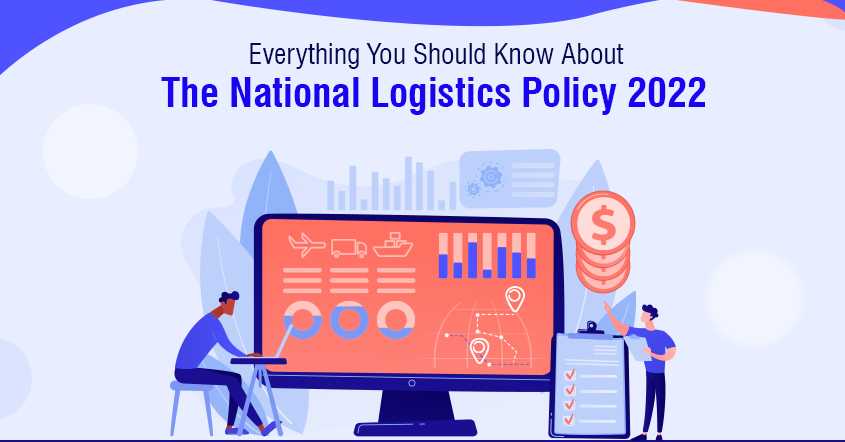Everything You Should Know About The National Logistics Policy 2022

The word “logistics” carries a variety of meanings. However, to put it simply, logistics is about gaining the “right product” to the “right place” at “right time.” The logistics sector duplicates the same functionality as the nerves that link various organs in the human body that carry out important and specialized tasks. The nation suffers when the logistics sector functions poorly, much as humans become disabled when their nervous systems malfunction. Governments have worked to reduce the logistics sector’s constraints in turn. These initiatives covered a wide range of logistics-related topics and were cross-sectoral. However, they were less successful than anticipated, which caused the industry to perform below expectations. The “National Logistics Policy 2022″ was created by the Indian government to increase the sector’s productivity and resilience. The policy and its implications are examined in the current story.
2022 New National Logistics Policy Objectives
- By 2030, bring India’s logistics costs into line with international standards.
- Attempt to rank among the top 25 nations in logistics performance by 2030.
- Make decisions based on data to support the processes of a successful logistics ecosystem.
National Logistic Policy 2022
The primary areas of this policy will be process re-engineering, digitization, and multi-modal transportation. It is a key decision since excessive logistical costs affect domestic products’ competitiveness in the global market.
“A national logistics policy was deemed necessary since India has higher logistics costs than other wealthy nations. , it is essential to lower logistics costs in India, To increase the competitiveness of Indian goods in both home and international markets according to a formal declaration. Lower logistics costs aim to increase economy-wide efficiency, allowing for value addition and business. According to the statement, the policy lays out an extensive interdisciplinary, cross-sectoral, and multijurisdictional framework for the growth of the entire logistics ecosystem to solve concerns of high cost and inefficiency.
The National Logistic Policy 2022: What’s New
The three main parts of the new national logistics policy are as follows:
- Action Plan for Comprehensive Logistics (CLAP)
- A platform for Unified Logistics Interfacing (ULIP)
- Dashboard for Logistics Service Simplicity (E-LogS)
Action Plan for Comprehensive Logistics(CLAP)
An extensive logistic action plan, which is broken down into eight core sections, will be used to carry out the NLP:
System for Integrated Digital Logistics
Create cross-sector use cases for logistics stakeholders by creating a system of unified logistics interface to connect several data sources.
Standardization of material possessions and comparison of service standards
Standardizing physical assets and comparing service quality standards in logistics may increase interoperability, reduce handling hazards, optimize processes, and make business easier.
Building capacity and developing human resources in logistics
Create a comprehensive human resource plan for logistics. Line ministries will create action plans by its guiding principles to address issues with internal capacity-building and skill development in the relevant sector.
State Participation
Establish a framework for institutional action at the city/state level, facilitate the development of state/city level logistics strategies, and evaluate and rank state action.
EXIM (Export-Import) Logistics EXIM (Export-Import) Logistics
It is important to close infrastructure and procedural gaps in India’s EXIM connectivity and develop a solid logistics network to strengthen trade competitiveness and further integrate India into regional and global value chains.
Framework for Service Improvement
Enhancing the regulatory interface to encourage formalization, standardization, and interoperability, remove the fragmentation in documentation, formats, and liability regimes, and close architectural gaps in the regulatory framework.
Sectoral Logistic Plan for Effectiveness
For each sector, Sectoral Plans for Efficient Logistics (SPEL) with underlying interoperability, resiliency, sustainability, and innovation philosophies will be designed by PM GatiShakti. SPEL would specifically:
- To create a better workforce, address logistics challenges relating to infrastructure, processes, digital advancements, regulations, and regulatory reforms.
- Prioritize cross-sectoral collaboration to enhance rather than duplicate efforts and concentrate on modal mix optimization.
Supporting the Growth of Logistic Parks
In the supply chain, logistics parks are hubs for intermediary activities (storage, handling, value addition, inter-modal transfers, etc.) connected by a transportation network. Examples include Multi Modal Logistics Parks, Air Freight Stations, Inland Container Depots, Container Freight Stations, Cargo Terminals, etc. The following actions are planned to be taken to facilitate the establishment of logistics parks:
- Developing Logistics Parks in the nation would be easier with the help of draught framework rules that encourage private investment.
- To improve visibility, logistics efficiency, optimal use, and connectivity, map the logistics parks on the PM GatiShakti NMP to create a network of parks.
A platform for Unified Logistics Interfacing (ULIP)
It has been determined that the Unified Logistics Interface Platform (ULIP) is a promising effort that has been developed to offer an integrated platform that can be used successfully by stakeholders to improve efficiency, utilize technology, and decrease the cost of logistics in India. We hope to create an “Atmanirbhar Bharat” in the logistics industry through this program.
The “Technology Commons” program, which uses technology to generate top-notch goods and services in several clearly defined priority areas, selected ULIP as one of its seven initiatives. The Integration, Governance, and Presentation layers are the three levels that make up the entire ULIP platform. The objective is to create a framework similar to UPI to enable the logistics department’s transactions to be authorized.
Seven ministries would be combined on a single platform as part of ULIP to provide logistics businesses with information regarding freight movement around the nation. The government will also incorporate 17 digital sites from the seven ministries into ULIP. Through ULIP, which will also help in issuing approvals for cargo transit, logistics companies, importers, and exporters would have access to data on cargo movement across the country.
Dashboard for Logistic Service Simplicity (E-LogS)
E-logs, also known as Ease of Logistics, is a digital platform created by the DPIIT’s Logistic Division to allow time-bound issue resolution. Authorized user associations will register and upload complaints on this digital platform, built for registering, coordinating, and monitoring resolution for user issues.
There will be 5 phases in the registration process:
- Enter the gateway.
- Add problems or ideas with one or more stakeholders.
- Include a title and priority and submit the necessary paperwork.
- SIG (system improvement group) will upload the decision after evaluating your papers and consulting with the Ministry/Department.
- The affected user is shown the issue’s resolution.
Like the Network Planning Group (NPG), the Service Improvement Group (SIG) was created to coordinate and keep an eye on resolving consumer complaints about services. Officers chosen by ministries make up this group.
Final Thoughts
The national logistics policy can create a trillion-dollar economy by organizing the highly important yet dispersed sector. The tech-enabled solution with improved infrastructure will strengthen the Indian logistic industry, ecosystem, and supply chain through the policy.
National Logistics Policy India would provide prosperity to the nation, decrease logistics costs, increase international trade, assist India in becoming “Atmanirbhar,” or self-sufficient, and provide new opportunities for our startups. The program would benefit farmers across the nation since it would speed up their products’ marketing, cut waste, eliminate useless delays, and lower costs overall.
The National Logistics Policy is the logical progression from the PM Gati Shakti National Master Plan and would offer a clear blueprint for developing the logistics ecosystem.



